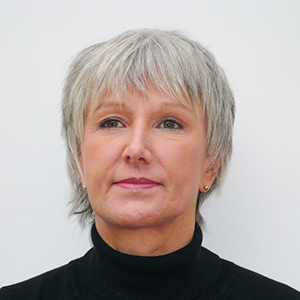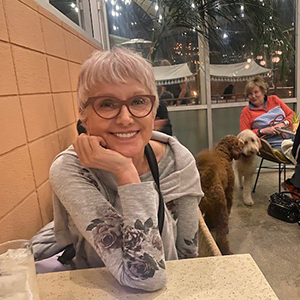
Data Matters: Dagmar Amtmann's whole-person approach to measurement

When Professor Kurt Johnson hired a program assistant back in 1992, he quickly realized he’d made a mistake. He’d vastly underestimated his new hire. “That didn’t work out too well,” he laughs. “She was way more competent than program assistant!”
That assistant was Dr. Dagmar Amtmann. In the more than three decades since she started at the University of Washington, she has become a national leader in rehabilitation science, a pioneer in health outcomes measurement, and a respected mentor in the UW Medicine Department of Rehabilitation Medicine. Now stepping into emeritus status, Dr. Amtmann leaves behind not just a legacy of scientific rigor—but a career defined by deep care for patients, clinicians, and the entire rehabilitation research community.
Born in Bratislava, Slovakia, Dr. Amtmann came to Seattle by way of Maine. “I wanted to go to graduate school,” she recalls, laughing, “and mistakenly I thought that if you worked for the university, they’d pay your tuition—which turned out not to be true.” Still, she stayed. “I very much enjoyed the research environment and just kept getting degrees until I could be on my own and do my own research.”
In 2002, she received her PhD in Educational Psychology, specializing in measurement and statistics. She had already begun teaching at UW, starting as a lecturer in 2000 and progressing to the rank of professor by 2014. Within two years of earning her doctorate, she secured a major NIH grant as part of the Roadmap Initiative on Patient-Reported Outcomes Measurement. She was the junior investigator among a cohort of senior leaders from across the country. “Dagmar was a newbie,” says Dr. Johnson, “but she quickly earned the respect of others because of her competence and the depth of her knowledge. She rose to have national status in the field.”
That national status was built, in large part, on her pivotal role in the development of PROMIS—the Patient-Reported Outcomes Measurement Information System. Funded by NIH and built on a foundation of cutting-edge measurement theory, PROMIS includes over 300 measures of physical, mental, and social health for use with adults and children in the general population and who are living with chronic conditions.
“Before PROMIS,” explains Dr. Amtmann, “we were kind of stuck in the world of classical test theory instruments. You’d go to the doctor and get a 20-item questionnaire. And they would try to make decisions based on that.” A full range of questions about the mental and physical health of a person might take hours to work through. Her work helped introduce modern measurement theory into the health sciences. These new methods, such as item response theory, allowed researchers and clinicians to ask fewer but more meaningful questions. “We wanted to figure out how to ask the right questions—questions that matter to both clinicians and patients. And how to provide scores that clinicians could use, and patients could understand.” In essence, she explains, “We tried to move measurement in health sciences to the 21st century—and make it more meaningful to both clinicians and patients.”
The result is a widely used set of tools that allow for a nuanced and patient-centered approach to care. “You get a score,” she explains, “and you know immediately how the patient compares to the general population, or to others their age, sex, education level. That makes it clinically meaningful.” For example, doctors frequently ask patients to fill out a depression screen during patient visits. Thanks to tools like PROMIS, doctors know how the average person scores, and when a patient’s score requires more follow-up.
A key element that makes PROMIS so useful is the extensive work that validated the results for a range of people of all ages, walks of life, and health status. To develop PROMIS, 20,000 people across all walks of life were surveyed. Ongoing work has helped to refine the data.
The PROMIS project created a general model for use across many conditions and stages of life, but Dr. Amtmann’s work has also helped researchers focus on helping individuals with specific conditions. She’s worked with researchers like Dr. Brian Hafner, who is exploring how to match people with amputations to the prosthetic that will best help them move through their day. She’s also worked on studies in multiple sclerosis, chronic pain, and epilepsy.
Despite her focus on measurement, Dr. Amtmann’s work has always centered people, not just data. That’s evident in her leadership of the Burn Model System data center, which tracks long-term outcomes for people who have experienced serious burns. “A lot of clinicians considered burn injury to be an acute injury,” she explains. Unfortunately, “that’s not how it works. If they have serious burns, it affects their physical function, their mental health, their social life. People end up with lifelong symptoms.” To better address the whole person, the Burn Model System has created a series of questions that consider all major areas of health and life, including mental health, social life, employment, sexual function, and more. By better understanding possible effects of burn injury, many problems can be helped or prevented.
This same whole-person approach has guided her work across many conditions, from multiple sclerosis to chronic pain to communication disorders. “I’m a methodologist,” she says simply. “So I can work across many content areas. What connects it all is the need for good, valid, interpretable measures.”
She’s also helped train the next generation. Over her career, Dr. Amtmann has mentored countless doctoral students and postdocs, taught graduate courses in health outcomes measurement, and collaborated across disciplines to build a stronger field. As she steps back from full-time research, she does so with a sense of trust. “I feel like I’m leaving things in good hands,” she says. “I have great confidence in my colleagues to carry this work forward.”

That said, her departure will leave a gap. “A lot of what I do just won’t get done at UW anymore,” she says candidly. “There aren’t other people with my background. But I hope the measures we developed continue to be maintained and used—they need constant upkeep, or they get stagnant. Measures aren’t perfect. They’re like people. They need care.”
Although she’s officially emeritus, Dr. Amtmann is still active in two projects: one continuing her work with the Burn Model System, and another new study with longtime collaborator Dr. Mark Jensen, exploring the effects of treatment on families of children with severe epilepsy. “It’s mostly qualitative,” she says. “We're interviewing parents and caregivers, trying to understand not just how the treatment affects the child, but the whole family.”
For now, though, her days are quieter. While she still lives in Seattle, she spends time as a snow bird in Palm Desert, California, in the winter. There, she plays pickleball, enjoys the sunshine, and reflects on a career well spent. “I’m really grateful,” she says. “To have been part of the department, part of PROMIS, part of something that really matters. Data and research really do matter to people.”
